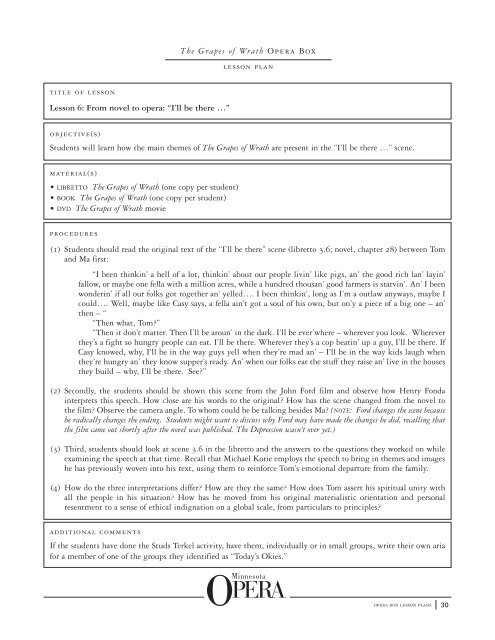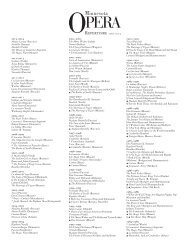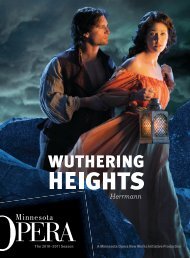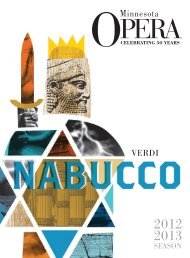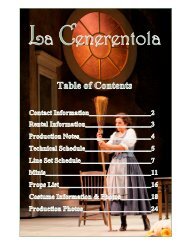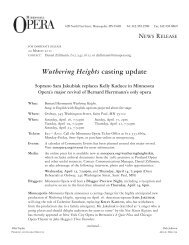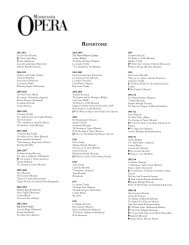You also want an ePaper? Increase the reach of your titles
YUMPU automatically turns print PDFs into web optimized ePapers that Google loves.
The <strong>Grapes</strong> of Wrath <strong>Opera</strong> Box<br />
lesson plan<br />
title of lesson<br />
Lesson 6: From novel to opera: “I’ll be there …”<br />
objective(s)<br />
Students will learn how the main themes of The <strong>Grapes</strong> of Wrath are present in the “I’ll be there …” scene.<br />
material(s)<br />
• LIBRETTO The <strong>Grapes</strong> of Wrath (one copy per student)<br />
• BOOK The <strong>Grapes</strong> of Wrath (one copy per student)<br />
• DVD The <strong>Grapes</strong> of Wrath movie<br />
procedures<br />
(1) Students should read the original text of the “I’ll be there” scene (libretto 3.6; novel, chapter 28) between Tom<br />
and Ma first:<br />
“I been thinkin’ a hell of a lot, thinkin’ about our people livin’ like pigs, an’ the good rich lan’ layin’<br />
fallow, or maybe one fella with a million acres, while a hundred thousan’ good farmers is starvin’. An’ I been<br />
wonderin’ if all our folks got together an’ yelled…. I been thinkin’, long as I’m a outlaw anyways, maybe I<br />
could…. Well, maybe like Casy says, a fella ain’t got a soul of his own, but on’y a piece of a big one – an’<br />
then –“<br />
“Then what, Tom?”<br />
“Then it don’t matter. Then I’ll be aroun’ in the dark. I’ll be ever’where – wherever you look. Wherever<br />
they’s a fight so hungry people can eat. I’ll be there. Wherever they’s a cop beatin’ up a guy, I’ll be there. If<br />
Casy knowed, why, I’ll be in the way guys yell when they’re mad an’ – I’ll be in the way kids laugh when<br />
they’re hungry an’ they know supper’s ready. An’ when our folks eat the stuff they raise an’ live in the houses<br />
they build – why, I’ll be there. See?”<br />
(2) Secondly, the students should be shown this scene from the John Ford film and observe how Henry Fonda<br />
interprets this speech. How close are his words to the original? How has the scene changed from the novel to<br />
the film? Observe the camera angle. To whom could he be talking besides Ma? (NOTE: Ford changes the scene because<br />
he radically changes the ending. Students might want to discuss why Ford may have made the changes he did, recalling that<br />
the film came out shortly after the novel was published. The Depression wasn’t over yet.)<br />
(3) Third, students should look at scene 3.6 in the libretto and the answers to the questions they worked on while<br />
examining the speech at that time. Recall that Michael Korie employs the speech to bring in themes and images<br />
he has previously woven into his text, using them to reinforce Tom’s emotional departure from the family.<br />
(4) How do the three interpretations differ? How are they the same? How does Tom assert his spiritual unity with<br />
all the people in his situation? How has he moved from his original materialistic orientation and personal<br />
resentment to a sense of ethical indignation on a global scale, from particulars to principles?<br />
additional comments<br />
If the students have done the Studs Terkel activity, have them, individually or in small groups, write their own aria<br />
for a member of one of the groups they identified as “Today’s Okies.”<br />
opera box lesson plans 30


